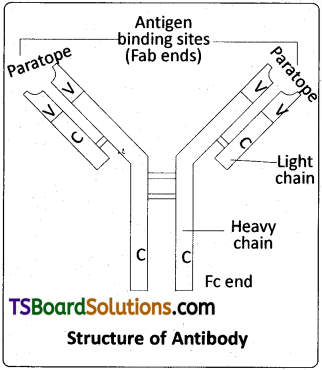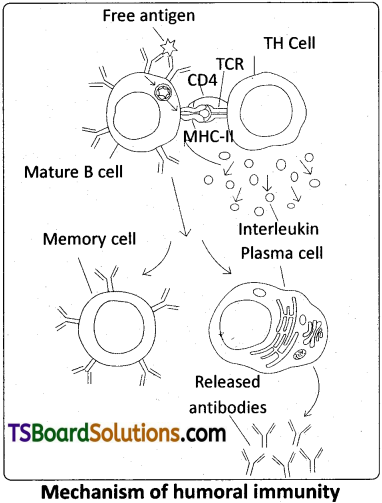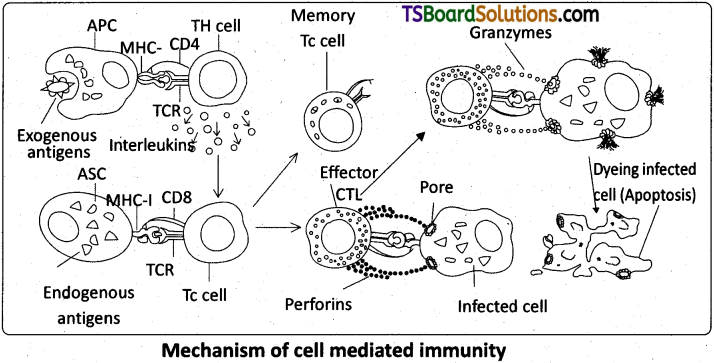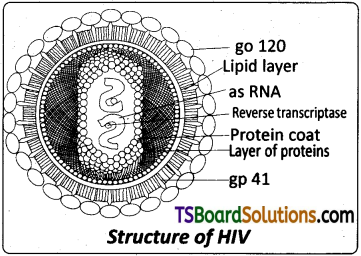Telangana TSBIE TS Inter 2nd Year Zoology Study Material Lesson 4(b) Immune System Textbook Questions and Answers.
TS Inter 2nd Year Zoology Study Material Lesson 4(b) Immune System
Very Short Answer Type Questions
Question 1.
Define the terms immunity and immune system.
Answer:
The over all ability of an individual to fight against the disease causing organisms is called immunity. The network of organs, cells and proteins that protect the body from harmful, infectious agents such as bacteria, viruses, animal parasites, fungi etc., is called the immune system.
Question 2.
Define the non-specific lines of defence in the body.
Answer:
The inborn resistance to diseases, possessed by all the living organisms is called innate immunity. It is a non specific type of defence and does not depend on prior contact with the micro – organisms. This is executed by providing different types of barriers.
Question 3.
Differentiate between mature B – cells and functional B – cells.
Answer:
Mature B – cells synthesize various types of antibodies which are displayed on their membrane surfaces. As these antibodies can take antigens, the mature B – cells are also called immuno – competent B cells.
These mature immuno – competent B cells reach the secondary lymphoid organs and develop into functional immune cells which later differentiate into long lived memory cells and effector plasma cells.
Question 4.
Write the names of any four mononuclear phagocytes. [March 2020, May 2017 (A.P.)]
Answer:
Mono nuclear phagocytes are 1) histocytes 2) Kupffer cells 3) microglia 4) osteoclasts 5) synovial cells.
Question 5.
What are complement proteins? [March 2017 (A.P.)]
Answer:
These are a group of inactive plasma proteins and cell surface proteins when activated, they form a membrane attack complex (MAC). Complement proteins and their activities are together called complement system.
![]()
Question 6.
“Colostrum is very much essential for the new born infants”. Justify. [May 2017 (A.P.)]
Answer:
The colostrum secreted by the mother during the initial days of lactation has abundant Ig A antibodies, to protect the infant. It is called natural passive acquired immunity.
Question 7.
Differentiate between perforins and granzymes. [Mar. ’17 (A.P.); Mar. ’15 (T.S.)]
Answer:
Cytotoxic T lymphocytes attach to the infected cells and release certain enzymes called perforins and granzymes.
Perforins form pores in the cell membrane of the infected cells. Then granzymes enter the infected cells through these perforations and activate certain proteins which help in the destruction of the infected cell.
Question 8.
Explain the mechanism of vaccination or immunization.
Answer:
The principle of vaccination or immunization is based on the property of the memory of the immune system. During vaccination, inactivated pathogens or antigenic proteins of pathogen are introduced into the body of host. They initiate the production of appropriate antibodies in the host and also generate memory B cells and memory T cells.
Question 9.
Mention various types of immunological disorders.
Answer:
Various types of immunological disorders are
- Acquired immuno deficiency syndrome (AIDS)
- Hyper sensitivity disorders (Allergies)
- Auto immune disorders (Graves disease, Rheumatoid arthritis)
- Graft rejections.
Question 10.
“More and more people in metrocities of India are prone to allergies Justify.
Answer:
More and more children in metro cities of India suffer front allergies leading to asthmatic attacks due to environmental pollutants. This could be mostly due to exposure to various types of pollutants in the urban atmosphere.
Question 11.
What are autoimmune disorders? Give any two examples.
Answer:
In some cases our immune system fails to recognise some of our own body proteins and treats them as foreign antigens that results in attacks on our own tissues. This leads to some very serious diseases collectively known as auto – immune diseases, e.g: Graves’ disease, Rheumatoid arthritis.
![]()
Question 12.
How can the graft rejections be avoided in patients?
Answer:
Graft reactions can be avoided in patients by tissue matching and blood group matching. Even after this, the patient has to take immuno – suppressant drugs throughout their life.
Short Answer Type Questions
Question 1.
Write short notes on B – cells. [March 2020, March 2014; May/June ’14]
Answer:
B – cells (B – Lymphocytes): The lymphocytes capable of producing antibodies and can capture circulating antigens are called B – cells. They are produced from the ‘stem cells’ in the bone marrow of adult mammals, liver of foetus and bursa of Fabricius in birds. Mature B – cells synthesize various types of antibodies which are displayed on their membrane surfaces. As these antibodies can take antigens, the mature B – cells are also called immuno – competent B – cells.
These mature immuno – competent B – cells reach the secondary lymphoid organs and develop into functional immune cells which later differentiate into ‘long lived’ memory cells and ‘effector’ plasma cells. The plasma cells produce antibodies specific to the antigen to which they are exposed. Memory cells store information about the specific antigens and show quick response, when the same type of antigen invades the body later.
Question 2.
Write short notes on immunoglobulins. [March 2019 (A.P.) March 2015 (T.S.)]
Answer:

Antibodies (Immunoglobulins) :
Whenever pathogens enter our body, the B – lymphocytes produce an army of proteins called antibodies to fight with them. They are highly specialized for binding with specific antigens. The part of an antibody that recognizes an antigen is called the paratope (antigen binding site). Based on their mobility, antibodies are of two types, namely circulating or free antibodies and surface antibodies. The circulating or free antibodies are present in the body fluids whereas the surface antibodies are present on the surface of the mature B – cells as well as the memory cells.
Structure :
The basic structure of an antibody was proposed by Rodney Porter. It is a Y shaped molecule with four polypeptide chains of which two are long, identical heavy chains (H) and two are small, identical light chains (L). Hence, an antibody is represented as H2L2. The two chains are linked by disulphide bonds. One end of the antibody molecule is called Fab end (Fragmentantigen binding) and the other end is called Fc end (Fragment – crystallizable or Fragment – cell binding). Based on the structure, the antibodies are of five types, namely IgD, IgE, IgG, IgA and IgM.
![]()
Question 3.
Describe various types of barriers of innate immunity.
Answer:
The inborn resistance to diseases, possessed by all the living organisms is called innate immunity. It is a non – specific type of defence and does not depend on prior contact with the micro – organisms. This is executed by providing different types of barriers like :
a) Physical barriers :
Skin and mucous membranes are the main physical barriers. Skin prevents the entry of micro – organisms whereas the mucus membranes help in trapping the microbes entering our body.
b) Physiological barriers :
Secretions of the body like HCI in the stomach, saliva in the mouth, tears from the eyes are the main physiological barriers against microbes.
c) Cellular barriers :
Certain types of cells like polymorpho – nuclear leukocytes (PMN – neutrophils), monocytes and natural killer cells in the blood as well as macrophages in the tissues are the main cellular barriers. They phagocytose and destroy the microbes.
d) Cytokine barriers :
The cytokines secreted by the immune cells are involved in differentiation of the cells of immune system and protect the non – infected cells from further infection.
Question 4.
Explain the mechanism of humoral immunity.
Answer:

Mechanism of Humoral immunity (HI) :
In the secondary lymphoid organs, the free antigens bind to the Fab end of the antibodies that are present on the surface of mature B – cells. They engulf and process the antigens. Then they display the antigenic fragments on their membrane with the help of Class-IIMHC molecules. Then appropriate TH cells recognize them and interact with the antigen – MHC – II complex and release a type of interleukin, which stimulates the B – cells to proliferate and differentiate into memory cells and plasma cells. The plasma cells release specific antibodies into the plasma or extra cellular fluids. These antibodies help in opsonising and immobolising the bacteria, neutralising and cross linking of antigens leading to agglutination of insoluble antigens and precipitation of soluble antigens. They also activate the phagocytes and complement system.
Question 5.
Explain the mechanism of cell mediated immunity.
Answer:
Mechanism of cell mediated immunity (CMI) :
Antigen presenting cells process the exogenous antigens whereas the altered self – cells process endogenous antigens. Then, the processed antigenic fragments are displayed on their (APCs or ASCs) membranes. They are recognised byT -cells. Binding of T -cells to the APCs or ASCs causes the production of activated T cells and memory T cells. The activated TH cells secrete various types of interleukins which transform activated Tc cells into effector cytotoxic T – Lymphocytes (CTLs / Killer cells). They attach to the infected cells and release certain enzymes called perforins and granzymes.
Perforins form pores in the cell membrane of the infected cells. Then granzymes enter the infected cells through these perforations and activate certain proteins (e.g. caspases) which help irt the destruction of the infected cell (apoptosis). The NK cells are similar in their action to CTLs. However NK cells destroy the infected cells in an antibody independent manner where as the CTLs destroy the infected cells in an antibody dependent manner.

![]()
Question 6.
Explain the mechanism by which HIV multiplies and leads td AIDS.
Answer:

After getting into the body of a person, the HIV enters the TH cells, macrophages or dendritic cells. In these cells the ssRNA of HIV synthesizes a DNA strand ‘complementary’ to the viral RNA, using the enzyme reverse transcriptase. The reverse transcriptase also catalyses the formation of the second DNA strand ‘complementary’ to the first strand forming the double stranded viral DNA. This viral DNA gets incorporated into the DNA of the host cells DNA by a viral enzyme (integrase) and it is in the form of a ‘provirus’. Transcription of DNA results in the production of RNA, which can act as the ‘genome’ for the new viruses or it can be translated into viral proteins. The various components of the viral particles are ‘assembled’ and the HIV are produced.
The infected human cells continue to produce virus particles and in this way they act like HIV generating factories. New viruses ‘bud off’ from the host cell. This leads to a progressive decrease in the number of TH cells in the body of an infected person leading to the immunodeficiency in him. Even though HIV attacks cells with CD4 marker, for reasons not known, only TH cells are destroyed and not the ‘macrophages’. The gp 120 molecules on the surface of HIV attach to CD4 receptors of human cells, mostly the TH cells (gpl20 fits the CD4 marker). Attack on certain types of cells/ tissues only by viruses such as HIV is refered to as ’tissue tropism’.